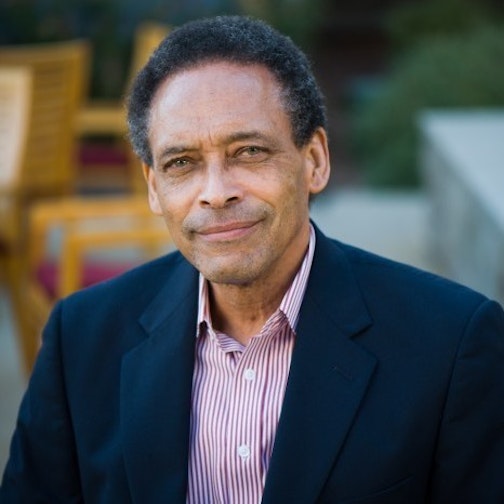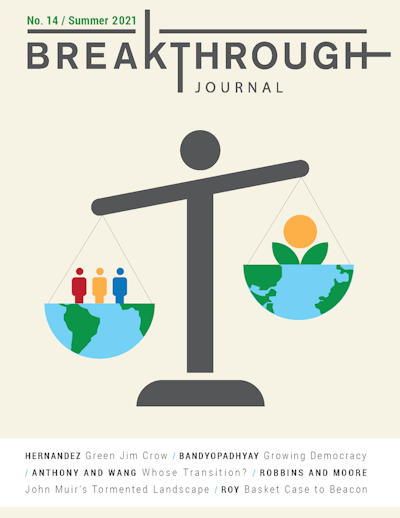Ecomodern Justice
Introducing Issue 14 of the Breakthrough Journal
-
-
Share
-
Share via Twitter -
Share via Facebook -
Share via Email
-
This issue of the Breakthrough Journal engages in an emergent search for “ecomodern justice” as an essential next phase in the development of ecomodernism. As two of the 18 authors of An Ecomodernist Manifesto (June 2015), we undertake this effort, mindful of more familiar terrain: discussions and activism spawned from calls for “environmental and climate justice” and more recently, “a just transition.”
Embraced by activists, academics, and policymakers over many years, these earlier framings have successfully placed the needs and aspirations of low-income and minority communities on national and global policy agendas. They have advanced efforts toward procedural justice via public consultation, environmental impact assessments, and other efforts to ensure that marginalized communities have a greater say. This includes input into siting, cleanup, and other policymaking that has some impact on who bears the environmental burdens of technology, infrastructure, and pollution.
But these efforts arguably may do so at the expense of attention to practical policy measures for addressing deeply-rooted social inequities that pollution-centered policy discourse simply cannot reach. Having one’s attention riveted by the landmark controversies that have played out over the decades under the label “environmental justice” may potentially mislead individuals into thinking that “justice” will be attained when no person or group is exposed or proximate to anything possibly injurious.
In the American context, the term “environmental justice” conjures an ongoing battle against the perceived hazards of industrial processes – for example, manufacturing, transport, storage, and disposal – and the systems that have imposed them or allowed them to be imposed on the politically and economically vulnerable, especially communities of color. As such, environmental justice is largely defensive, focused on inequitable exposure to risk. Overt harm is being done or threatened and must be stopped.
In India, such activism has featured a similarly wide variety of issues affecting poor, tribal, and marginalized communities in battles against development-led displacement and eviction of people from their livelihoods and lands, destruction of forests, and local air and water pollution. As in the United States, courts have been pressed to determine whether suffering merits relief. In Bangladesh and island nations, “climate justice” rises to the forefront as the prospect of intensifying natural disasters attributable to human-induced climate change threaten catastrophe.
By contrast, an ecomodern justice agenda might focus more on equitable benefits, rather than inequitable burdens and risks. Ecomodern justice could emphasize the need for distributive justice for historically disadvantaged communities around the world. That is, it might focus upon ensuring greater access to the infrastructure and technologies that have transformed human societies in the modern era, as well as emerging technologies, rather than on disparities in exposure to the risks these technologies have imposed.
As a work-in-progress, conceptions of ecomodern justice will likely evolve less through academic theorizing than in response to a diversity of opportunities and problems in specific spheres of policy. This type of justice might pursue interventions that are simultaneously Earth sparing, technologically innovative, and poverty alleviating or opportunity enhancing. We hope that debate about which variety of ecomodern justice to prioritize will be robust and range well beyond the borders of any one country.
Should it be restorative, transitional, or intergenerational? How should it address ethnic identities and cultural differences? Should it be fully egalitarian or aim for adequate floors below which no one can fall? Should it be based on equalizing capabilities, or outcomes? Should strategy be universalist, aiming to pull the disadvantaged along in coalitions of submerged distinction? Where might means testing and benefit eligibility come into play? And perhaps most profoundly, how deeply can democratic participation penetrate in an endeavor so strongly anchored in cutting-edge scientific and technical matters?
We set to work on this issue of the Breakthrough Journal, aware of the very tough nut we want to begin cracking.
1.
The essays in this issue reflect on widely disparate contexts in which modernization has raised important questions regarding the inclusion of disadvantaged groups. By no means are these analyses uniformly accounts of oppression. Indeed, one striking feature of this particular compilation is that, on balance, the offerings addressing south Asia provide optimistic accounts stressing socio-economic uplift while those grounded in the American experience lead us toward more distressing, even disturbing, conclusions.
In “Basket Case to Beacon,” Joyashree Roy pushes back against the conventional stereotype of Bangladesh as a desperately poor land, barely above sea level and waiting to drown, absent some sort of miraculous rescue. To be sure, Bangladesh is still much poorer than many advanced developed economies. And its unique topography makes it highly vulnerable to rising seas and intensifying storms. But if Bangladesh is indeed merely a poster child of all that might go wrong as the climate warms, someone forgot to tell the Bangladeshis.
Since gaining independence from Pakistan 50 years ago, Bangladesh has moved most of its population out of poverty. It has seen a precipitous drop in mortality and displacement associated with tropical cyclones and marked, sustained improvement across virtually every human development metric. It seeks developed-world status within 20 years and, with the right mix of infrastructure investments and energy development, is poised to take its own distinctive place among emerging economies of Asia.
Bangladesh has done so by investing wisely in science, technology, infrastructure, institutions and education, and most importantly by empowering its own people, proving that justice need not take a backseat to modernization and development. All are best pursued hand in hand.
Energy development has had a central role in these efforts, notably Bangladesh’s development of its abundant natural gas reserves and prioritization of those reserves for productive use in the domestic economy, rather than export. As those reserves begin to become depleted, and faced with the need to decarbonize its grid, the nation faces important choices about the future of its energy economy. But that will almost certainly involve finding creative ways to transition that vast infrastructure toward a mix of energy sources that will sustain both the environment and the people of Bangladesh, rather than abandoning it.
In “Growing Democracy,” historian Ritajyoti Bandhyopadhyay takes a fresh look at the period between the 1960s and the 1980s, when India achieved food self-sufficiency via prodigious improvements in agricultural productivity. Against long-standing claims to the contrary, Bandhyopadhyay argues that India’s Green Revolution was both necessary to assure Indian self-determination in the face of Western powers ready to use food as a weapon and played an essential role in India’s evolution into a vibrant multi-party democracy.
Bandhyopadhyay focuses on Punjab, India’s bread basket and rice bowl, which flourished thanks to enormous state investments in water and power, programs to support adoption of new seeds and fertilizer, and policies that guaranteed farmers stable incomes and incentivized them to grow essential crops. Those policies ended India’s dependence on food imports. They also gave farmers – and rural populations more broadly – a much greater voice and interest in state and national politics, facilitating a rural political coalition that cut across divisions of caste, ethnicity, region, and class.
Roy and Bandyopadhyay invite us to reconsider misperceptions of poor nations and populations as victims, lacking agency within modernization processes. In a different realm, geographers Paul Robbins and Sarah Moore use John Muir’s memoir and final published work to reflect on the ways in which the American conservation movement was borne of conquest and dispossession. It not only erased Native people from the wilderness cathedral but banished any acknowledgement that the frontier from which conservationists sought to carve those cathedrals had been violently taken from its original inhabitants. In “John Muir’s Tormented Landscape,” Robbins and Moore offer a novel psychoanalytic analysis, suggesting that by repressing the original conquest of the American frontier, Muir and the conservation movement continually reproduce it through the conservation movement’s own nature-saving conquests. Muir’s reverence for the lofty hand of God may have aided the rather less lofty aims of white men. This tendency continues even today as a privileged conservation movement continually finds ways to reify theological notions of nature and wilderness in service of what too often remains an exclusionary project.
In “Whose Transition?” Maya Anthony and Seaver Wang recount the difficult struggle by the Navajo Nation to win control over their energy and mineral resources. For the Navajo Nation, self-government and self-determination have coevolved over decades with the development of energy resources, particularly coal. Faced with demands to abandon coal by people both on and off the reservation, Navajo leaders are deeply conflicted because much of both the tribal economy and tribal government depends upon it.
Suggestions that the tribe rapidly transition to producing wind and solar energy are fanciful at best. Coal mining and power-plant generation support hundreds of permanent, high-paying union jobs on the reservation. Wind and solar development could only support a fraction of that. Moreover, because coal is mined, processed, and burned on the reservation, Navajo Nation captures far more of the value chain associated with the coal economy than it could in the renewable economy.
Considering this Hobson’s choice, Anthony and Wang conclude that the operating principle must be native sovereignty and self-determination. Whatever course the Navajo choose, it must be their choice, not one foisted upon them by outsiders, as has been the case throughout so much of the tribe's tragic history. When and if the Navajo Nation transitions away from coal, it must be on its own terms and in its own time.
The Golden State loses considerable luster in “Green Jim Crow,” as veteran environmental attorney Jennifer Hernandez casts herself as a skunk at California’s sustainability garden party. In her telling, the leading-edge environmental policies the state has long trumpeted come with a dark underside: higher costs and diminished lives for the state’s lower-income, working class, and minority residents.
As the state has ramped up its climate ambitions over the last two decades, it has increasingly and disproportionately forced its poor, working class, and non-white residents to shoulder the burden. Rapidly rising housing, transportation, and energy costs have made long-standing wealth and income disparities worse. A state determined to drive carbon-intensive economic sectors out of the state is driving jobs that historically offered an entry into the middle class for non-college educated non-white workers out of state as well. Combined with prohibitive cost barriers to homeownership, the state’s climate agenda is killing off pathways to economic mobility that have historically offered people of color in the state a chance at the California dream.
This has all transpired in a state that boasts of being “majority minority” because the state’s well- heeled and overwhelmingly white environmental NGOs and philanthropies still wield enormous power. And so the state showers subsidies for solar panels, electric vehicles, bike lanes, rail extensions, and much else upon its wealthy white residents while raising living costs for the poor, non-white majority, all packaged in a misleading narrative about green growth and global climate leadership.
2.
Justice, it turns out, cannot be so easily achieved by bolting the term onto the end of various other progressive issues and concerns. Procedural and distributive justice claims are good at identifying power relations but often not so good at changing them. India could not achieve food security by demanding more food from Western powers. It had to seize the means of production so that it no longer depended upon food imports. Neither Bangladesh nor the Navajo Nation are well advised by well-meaning environmental activists to strand their fossil fuel assets and infrastructure to save the planet. They have contributed little to the problem and are the last places, not the first, that the world ought to be asking to bear costs associated with the energy transition. Indigenous people around the world will do well to resist entreaties to stand in for theological notions of nature in service of conservation’s latest exclusionary project. And true self-determination for California’s majority of minorities may require discommoding the white environmental technocrats who really run the place.
Social justice advocates, in other words, would be wise to beware environmentalists bearing gifts. Environmental problems are real and demand solutions. But claims by a historically white and wealthy environmental movement that there will be no tradeoffs or equity impacts for lower income people of color associated with efforts to regulate, tax, and otherwise manage their behaviors, consumption, and livelihoods should be viewed with a fair amount of skepticism.
An ecomodern alternative will focus on the broadly shared benefits of technology, the value of self-determination, and the necessity of infrastructure, industrial policy, and democratic institutions. It will not demand obedience to science from those who need technology more than anything. It will not romanticize poverty and antiquarian systems of production. And it will support poor countries, Indigenous communities, and people of color to pursue industrial modernity on their own terms, rather than asking the rich and powerful or the developed world for either permission or charity.



